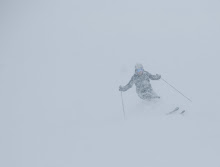The other night as I was drifting to sleep, I thought about catching and riding waves. I grew up by the ocean, and catching and riding waves is second nature to me. I began to think what it would be like to learn for the first time how to catch and ride a wave.
The first step is to enter the ocean. There are basically two ways - run through the surf and dive in immediately, or wade until just your head is above the water and slowly dunk. People who are comfortable with the ocean generally choose the first way. They just dive in, without regard to the water temperature, lacking knowledge of where the footing may drop off or become rocky, confident that they will skim through the water, stand, and be safe.
To others, just diving in is difficult. Gradual immersion, slowly testing the temperature, the current, and the footing (even checking for seaweed or - eek - jellyfish), is easier for people when the particular ocean spot is new or they are unfamiliar with the sea. This is probably the way a person intending to catch and ride a wave for the first time would enter.
Once in the ocean, and wet top to bottom, the next step is to gauge the waves and get a sense of where they begin to build, crest and then break. This takes experience so the first timer will need to watch carefully. Waves also come in series and I have tried to discern a pattern in which wave will break most evenly. There is no pattern. So, a person wanting to catch a wave must stand and watch, and stand and watch, but eventually commitment is necessary. To catch a wave, you decide "the next one is it". You move to where you think the wave will start to break and then watch as it begins to crest. At this point, you are looking out to the horizon over the sea. When the wave crests, you turn and swim hard until you feel that your power is no longer needed. Your arms then stay forward pointed like a steeple over your head and the wave propels you forward. Effort at this point is wasted; you are in the wave. Soon, you will sense the power fading and the closeness of the sand. At this point, I turn onto my back, riding the last glide and then get up. Whether I turn to my back or stay on my stomach, the wave has dissipated and I stand up and shake the sand out of my bathing suit.
Lessons learned from catching and riding a wave:
- You have to get into the water - run, wade, swim, but get in
- Observe the environment and see what is going on
- Commit - at some point, you need to turn and allow the wave to catch you
- Relax and enjoy the ride
- Life leaves its mark - there's always some sand in your bathing suit.

No comments:
Post a Comment